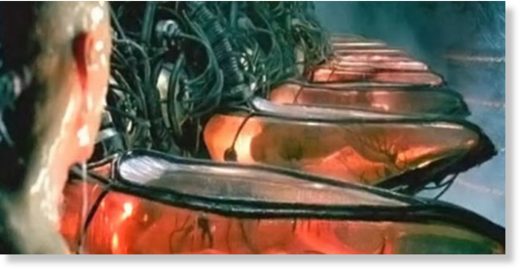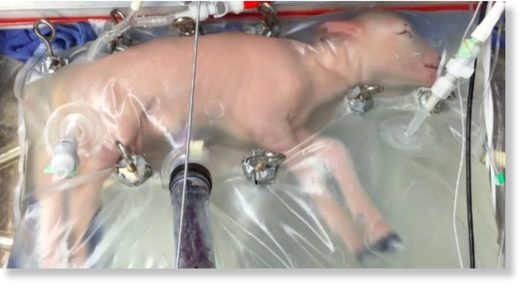
Some serious issues spring to mind: How about bonding and emotional development? It would play right into the NWO agenda of course, to have children born with no family bond and stunted emotions: Robots of The State. MH
John Vibes
Truth Theory
Sat, 18 May 2019 00:00 UTC

© The Matrix
The abortion debate is once again taking center stage in US politics, and the prospect of artificial wombs is slowly becoming a part of the conversation, as the technology is actually starting to become a reality. According to some experts in the field, we are just a decade away from this type of technology reaching the public.
Dr. Carlo Bulletti, associate professor at Yale University’s obstetrics, gynecology, and reproductive science department, has predicted that a fully functioning artificial womb could be used in the medical field in the next ten years.
Scientists call this Ectogenesis, which is an artificial pregnancy outside of the body. Numerous experiments have tested this process with animals and have been slowly advancing the success rates of the procedure. In the most notable of these experiments, a premature lamb was kept alive for weeks in an artificial womb.
There are still concerns about how a pregnancy like this would impact the health and mental development of the baby, considering the importance of bonding, but many experts insist that artificial births are the future.
In a recent interview with Metro, Dr. Anna Smajdor, associate professor of practical philosophy at the University of Oslo, explained that bonding can happen mentally, but did not address whether or not this could cause developmental issues for the baby.

© Study: Artificial womb technology and the frontiers of human reproduction: conceptual differences and potential implications
“Many arguments have been made about the necessity of gestation and childbirth for bonding. Although it may be true that the physical closeness between mother and baby facilitate bonding, it is certainly not true that it is necessary for bonding. If it were, fathers would have no claim to be bonded with their children. Not just this, but it is becoming increasingly clear that traumatic births actually impede maternal bonding, rather than the other way round,” Smajdor said.
“With developments in technology, increasingly, parents describe the moments of special bonding as being when they see the first scans. So this seems to imply that it is a visual connection that is regarded as being important rather than the physical one per se. Ectogenesis could actually facilitate this kind of visual bonding,” she added.
In an article for Wired, Tech writer Matt Chessen said that people in the future will find traditional pregnancy unappealing.
“Most future folk will find pregnancy – especially the delivery of an infant through a birth canal – messy and risky,’ technologist and author Matt Chessen wrote in Wired. ‘Creating a baby inside another human being is hazardous. The child’s health is dependent on the mother’s physical security as she navigates the world, and the fetus is susceptible to infections, poor nutrition, and other threats.” Chessen said.
Some researchers in the field have been even bolder than Bulletti with their predictions.
Last year, academic Elizabeth Chloe Romanis wrote in the BMJ’s Journal Of Medical Ethics that, “It seems probable that we are only several years away from testing on human subjects.”
Dr. Alan Flake, of the Children’s Hospital of Philadelphia, which carried out the most famous Ectogenesis experiment, believes that we could be just a year or two away from seeing this technology in FDA trials.
“We’re in the process of interacting with the [US Food And Drug Administration] FDA, so it’s not impossible that we could be doing a clinical trial one to two years from now,” Flake said.
This strange technology seems like something out of a dystopian film, but it could possibly provide a solution for women with health problems who still want to have children, and it could also make the abortion debate much more interesting in years to come. Although, even if there was an artificial way to continue a pregnancy outside of the body, this would not guarantee that there would be enough qualified parents to raise the children that resulted from all of these additional pregnancies.
About The Author
John Vibes is an author and journalist who takes a special interest in the counter culture, and focuses solutions-oriented approaches to social problems. He is also a host of The Free Your Mind Conference and The Free Thought Project Podcast. Read More stories by John Vibes
| Artificial Wombs – Ectogenesis Technology – Is On The Way Ectogenesis is the process of raising a human fetus outside the body, inside an artificial womb. e term ectogenesis was coined in 1924 by British scientist J.B.S. Haldane. The ectogenesis technology itself is highly complicated, though somewhat simple looking. Basically, it appears as an amniotic fluid-filled aquarium with a bunch of feeding tubes and monitoring cables attached to a live, developing organism. Those tubes bring the nutrients, oxygen, etc needed to grow an organism and help it survive; the cables monitor everything going on inside the tank. (Via Vice.com) There are two commonly cited endeavors in progress. Focusing on finding ways to save premature babies, Japanese professor Dr. Yoshinori Kuwabara of Juntendo University, has successfully gestated goat embryos in a machine that holds amniotic fluid in tanks. On the other end of the process focusing on helping women unable to conceive and gestate babies, is Dr. Helen Hung-Ching Liu, Director of the Reproductive Endocrine Laboratory at the Center for Reproductive Medicine and Infertility at Cornell University. Quietly, in 2003, she and her team succeeded in growing a mouse embryo, almost to full term, by adding engineered endometrium tissue to a bio-engineered, extra-uterine “scaffold.” More recently, she grew a human embryo, for ten days in an artificial womb. Her work is limited by legislation that imposes a 14-day limit on research projects of this nature. As complicated as it is, her goal is a functioning external womb. (Via Reproductive Health and Social Justice.) Science fiction films in particular have repeatedly shown us artificial wombs. In Star Wars Episode II, Obi Wan examines a clone factory line. SOURCE |









how it could possibly provide a solution for women with health problems who still want to have children?